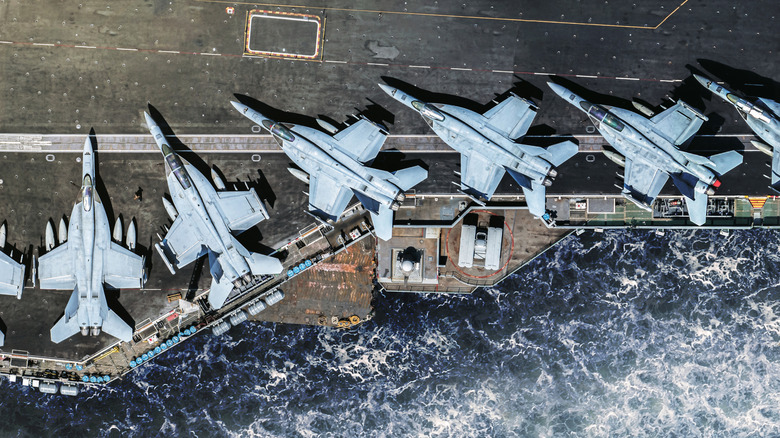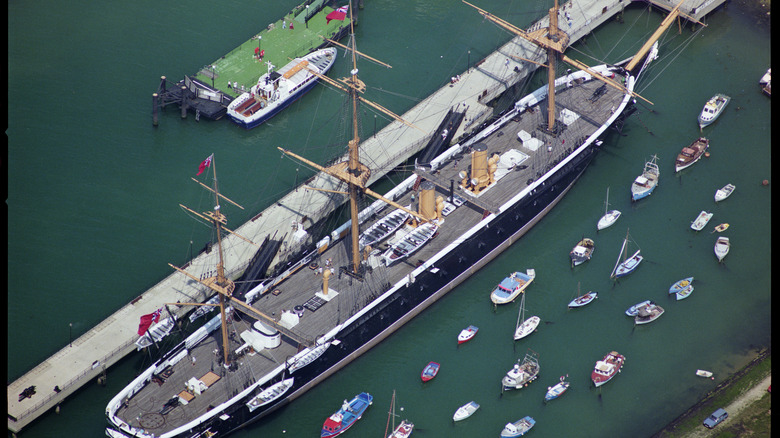Landing a fighter jet on an aircraft carrier is borderline surgical. The deck space is tight, typically only about 500 feet long, which is nowhere near enough for a jet going 150 mph to stop by brakes alone. Instead, pilots rely on a system of arresting wires stretched across the deck. A tailhook attached to the rear of the plane is lowered just before touchdown and aims to snag one of the four high-tensile steel cables. If successful, that hook drags the wire out, and a hydraulic system below deck absorbs the energy to bring the jet to a dead stop in around two seconds. The absence of this landing hook is one of the reasons Air Force planes cannot land on an aircraft carrier.
This arresting gear can stop a 54,000-pound jet traveling at 150 mph within 315 feet. If it misses, the pilot hits full throttle and launches off the end for another pass, called a “bolter.” The entire setup is built to catch, stop, or send the aircraft airborne again instantly. The deck itself is also angled about 14 degrees, so bolters don’t smash into parked aircraft on the forward deck.
Precision is everything here. The system doesn’t allow for sloppiness. Land too early and you might clip the ship. Land too late and you’re swimming. This was also why a fighter jet fell off an aircraft carrier in 2025. That’s why the tailhook and wire combo is one of the most critical parts of carrier operations.
The pilot’s approach: controlled chaos in a tight pattern
A carrier landing starts long before the wheels touch down. Jets circle the ship in a tight oval holding pattern called “the stack.” The ship’s Air Traffic Control decides landing order, mainly based on fuel levels. Once cleared, a pilot breaks from the stack and lines up behind the carrier, guided by the Landing Signal Officers (LSOs) via radio and light signals on the deck.
The pilot’s goal is to maintain the perfect glide slope all the way to the deck. To assist with this, a Fresnel Lens Optical Landing System projects lights that indicate whether the aircraft is too high, too low, or right on target. A centered amber light (nicknamed “the meatball”) aligned with green reference lights means a clean approach. If the amber light drifts, it tells the pilot to adjust immediately. Too low, and the light turns red, signaling danger of hitting the ship’s stern.
LSOs also stand by with the authority to “wave off” an aircraft if it’s coming in wrong. That decision needs to be made in split seconds. In combat or poor weather, there’s zero room for hesitation. Everything, from the approach pattern to light signals to real-time corrections, is designed to get the jet down safely on the first try.
A unique (but ultimately scrapped) way to land
After World War II, British engineers explored an idea that sounds bizarre today: landing jet aircraft on carriers without wheels. The Royal Aircraft Establishment (RAE) theorized that removing landing gear could reduce aircraft weight and allow for sleeker designs. In 1945, they proposed a flexible “carpet” deck: a shock-absorbing rubber-like surface that could catch a wheelless jet using standard arresting gear.
The first real test happened in December 1947 when veteran pilot Eric Brown attempted a landing in a Sea Vampire with the gear retracted. It didn’t go smoothly. The plane sank too fast, the arresting hook malfunctioned, and the aircraft was damaged on impact. Brown walked away, and refinements followed. By March 1948, the team achieved a successful flexible deck landing, and in November, Brown repeated the feat aboard HMS Warrior, a modified light carrier fitted with a 190-foot rubber runway.
More than 200 test landings followed, which were most successful. The system technically worked. It could stop a wheelless aircraft with a short runout and no major accidents. But real-world practicality killed the concept. Aircraft without wheels couldn’t land at regular airfields or unmodified carriers, limiting their use. Upgrading all infrastructure wasn’t worth the marginal performance gains.
The U.S. Navy tested its own version in 1953 at NAS Patuxent River, but faced similar drawbacks. The idea was shelved. But fighter jets that can take off and land without a runway (floating or otherwise) altogether have been developed and are in service today.


